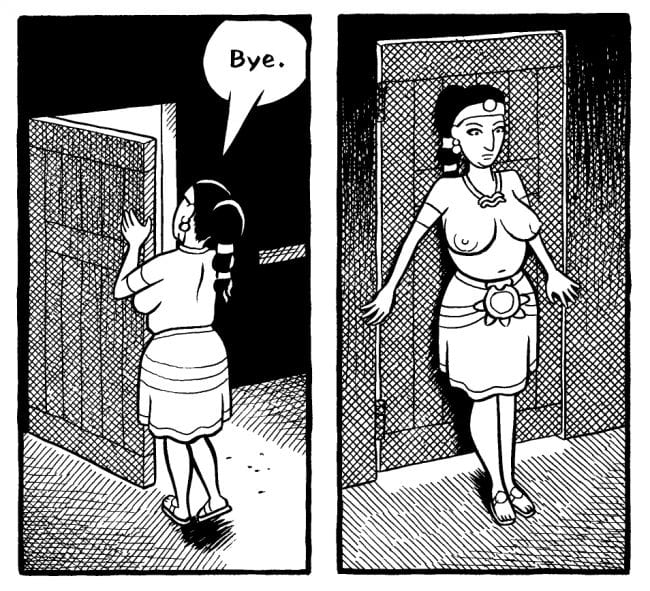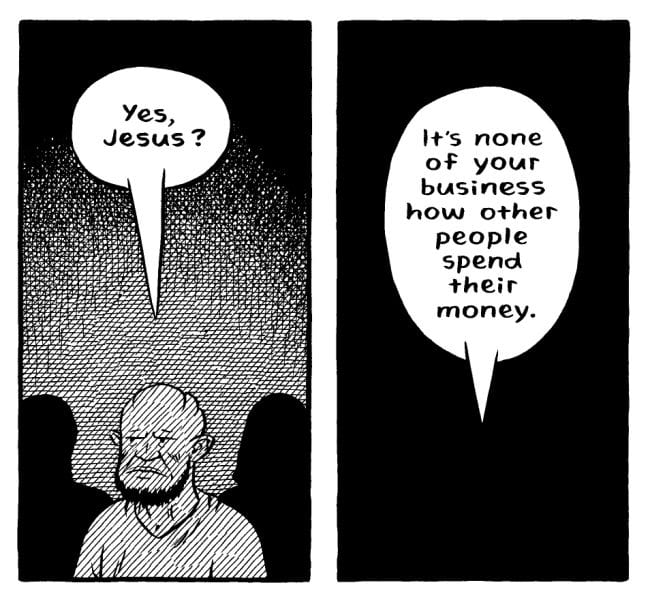Chester Brown’s Mary Wept over the Feet of Jesus is a logical extension of the examination to which he subjected himself in Paying for It (2011), and which in his work arguably goes back as far as The Playboy (collected 1992). These are comics that try to make sense of—and to justify—choices he makes in life by contextualizing them broadly, at times polemically. Paying for It, his account of life as a john and his argument for the decriminalization of prostitution (2011), was a magisterial, conflicted, and contradictory piece of confessional comics. Though similarly accomplished in terms of the cartooning, Mary Wept unfortunately risks tipping the balance toward idiosyncratic stridency.
Brown sifts through the Bible to find evidence of heroic prostitution. We get the Old Testament stories of two prostitutes, Tamar and Rahab, as well as that of Ruth, who was not a prostitute, and that of Batsheba, who was not one either. According to Brown the latter two engaged in “whorish” behavior and are therefore included (p. 154).
We also get the story from the Gospels of a prostitute, identified by John as Mary of Bethany, anointing Christ’s feet. In Brown’s hauntingly suggestive retelling of the story—a shadow play of silhouettes, close-ups, and disembodied Words—he intimates that this crucially symbolic preparation of Christ’s body for his sacrifice involved sexual intercourse, because the word "feet" was apparently often employed as a euphemism for "penis." Never mind that the literal reading of the word makes eminent sense here in terms of the customs of the period and the situation described, just as it does when Christ washes the feet of the apostles before the Last Supper (unmentioned by Brown), unless we are to understand that as some kind of orgy?
In Brown’s world, Paul is the villain of the piece, telling the Corinthians that "the body is not for prostitution but is set aside for the Lord" and thus censoring Jesus’ much more accepting line on the issue (p. 177–178). It is clear that Jesus did not condemn prostitutes anywhere in the Gospels, and we might therefore with reason extrapolate that he did not disapprove of sex for pay (although we cannot say whether he gave it much thought either). It is further reasonable to assume, as Brown does, that worldly prejudices and social mores informed later interpretations of Jesus’ words, not least in the case of the Evangelists. What does not follow automatically, however, is that Mary was a prostitute, but Brown is most intent on proving just that. This is the more fundamental reason for his retelling of the stories of the four women mentioned initially: Matthew included them in his—unusually female—genealogy of Jesus along with Mary, according to Brown because he wanted to slip the truth of Mary’s profession by the censors of his day—you know, those who were intent on furthering the idea of the Virgin birth.
I am not a theologian, nor am I a Bible scholar—I am not even Christian—but I think I know a contorted argument when I see one. Despite the quite strong differences between each of the four women and their sexual activities—Batsheba may even have been raped—the only reason Brown can see for Matthew’s genealogy is that Mary was a prostitute (p. 174). To him it breaks down like a kind of rebus dependent on all four parts:
RUTH (≈ pre-marital sex) + BATSHEBA (≈ extra-marital sex) + TAMAR (≈ transactional sex) + RAHAB (≈ multiple partners) ⇒ MARY = prostitute.
Alternatives having to do with their intelligence or virtue making the four women ideal ancestors to Jesus, or the notion that a female genealogy makes sense for his profane ancestry precisely because it originates with his mother, or simply with Jewish matrilineality, are not entertained.
More problematically, Brown deploys any counter-evidence in its negative sense, to confirm his argument, essentially explaining away contradictions by censorship or fear of it. Matthew clearly describes Mary as a Virgin, but for Brown that is because he wanted to throw the censors off the scent of his genealogy. Something similar goes for Luke, who also describes her as a virgin. And besides, the Greek word they used, "parthenos," is not a “clinically exact” term, Brown notes—yes, it is usually used to describe "a woman who has never had sex," but it could perhaps just mean a woman who is "sweet and innocent," something which it is entirely possible for a prostitute to be (pp. 203–204). By this point it seems that Brown has gotten hold of a hammer and sees every protruding bit of scripture as a nail.
Somewhat more interesting is his related reading of a number of Old Testament stories and parables told by Jesus in the service of an exegesis of individual agency and disobedience. Thus the story of Cain and Abel, for instance, becomes that of the freethinker Abel who disobeys his father’s—and God’s—instruction that man after the Fall must live from the plants of the field, to instead herd sheep and eat meat, and is favored by the Lord for it. Abel is drawn muscular and healthy; Adam and Cain are gaunt and appear undernourished.
Again, Brown’s methodology confuses. Firstly, the stories are cherry picked to serve his point—I would like, for instance, to see Brown interpret the story of Abraham’s sacrifice--inarguably a centrally important story in explicating man's relationship to God--in terms other than censorship. Secondly, when scripture does not quite offer him what he seeks, he enhances the text: the Prodigal Son is not merely taken in because his father loves him unconditionally: “I love you because of what you did, not despite it,” he explains in Brown’s version (p. 164), essentially flattening the message by specifying his reasons. For Jesus’ Parable of the Talents he dismisses the version told by Matthew in favor of a more authentic, lost “Nazarean” version mentioned by Eusebius, which he is convinced is true to how Jesus originally told the story (p. 176). Sticklers will—and already have—noted that his reading of Eusebius is bewilderingly circuitous.
Brown is dealing with centrally important contradictions in the Bible. It therefore makes sense when he suddenly breaks his copious flow of handwritten notes with a spartan, yet in passages breathtaking, adaptation of that most subversive of canonical books, Job. Who would have thought that God’s admonishment, “Where were you when I created the World”, could be contained so sublimely in nine small black and white panels? (pp. 232–235) (The ability to fathom in one panel the ocean and the cosmos speaks volumes about of Brown’s abilities as an image-maker, as does his counter-intuitively effective depiction of Satan as a cousin apparent to Hellboy Junior). Strangely, he does not address the seemingly contradictory part at the end where Job seems to be rewarded by God. This appears to me potentially a case of the ‘censorship’ Brown sees in so many other places: a tacked on happy ending bringing in line a story that undermines much of what is written elsewhere.
At heart, Mary Wept is a very conventionally Christian book. Essentially Brown is preaching Christ’s message that love supersedes the law and conquers all (cf. p. 215-216). And, as he correctly argues, disobedience of God is at the very root of the Bible’s conception of Man, contained as it is in the Fall from Grace.
It is therefore surprising that Brown apparently understands that particular story as the product of the (Mosaic) “less spiritually advanced school of thought” informing large parts of the Bible, which he contrasts with the (Messianic?) “more spiritually advanced school of thought” responsible for the stories he has cherry picked (p. 238). (Here, he cleaves perilously close to his countryman and fellow cartoon exegete Dave Sim’s nutty arbitration of scripture between the real “God” and the devilish “Yoohwhoo”). The Fall from Grace is our culture’s ur-narrative on free will, the expulsion from Eden the inevitable result of this gift from God and therefore—one would think—the very foundation of Brown’s libertarian confession. But apparently not?
Similarly, the scriptural fact is that Mary was unfaithful to Joseph, her husband who is not the father of Jesus. I would agree with Brown that this is essential to understanding her and potentially a key to the mystery of Christ’s message of love. Instead of exploring this further, however, Brown gets caught up in proving specifically that she was a prostitute without ever really explaining why we should care. There is no doubt that, if proven, Mary as a prostitute would cause great upheaval among Christians, but that in itself is hardly surprising or interesting. (And thankfully, pat iconoclasm is not Brown’s bag). His endeavor here seems at once too self-centered and too closely tied to a political agenda. Yes, on balance, I am in favor of the decriminalization of prostitution too, but Brown’s way of justifying it here is too arcane to add anything to the more interesting—and more interestingly contradictory—case he made in Paying for It.
Many thought that book too didactic, wishing Brown had not included its prolix appendices. I disagreed, finding that the frisson between the honestly conflicted, confessional comics narrative and the assertively polemical notes made for a richer work. Mary Wept would not work without the notes, but that is not really a good thing. Where the appendices in Paying for It constituted a little over a fifth of that book’s pages and were kept in check by a more densely organized, sustained narrative, the notes (and the notes to the notes, and notes to the notes to the notes) in the present book take up almost a third of the pages and enables the reader to make sense of what would otherwise have been a slight and incoherent collection of short Bible adaptations, however fascinating in their own right. The reason this is problematic is that the notes threaten to overwhelm the beautifully but also delicately brief comics to the point where the latter seem too much like illustrations of the points made in the notes. What is more, and in spite of Brown’s disarmingly honest discursive manner, his stridency and his lack of coherent methodology makes for oppressive, frustrating reading.
Still, Brown remains a hugely accomplished cartoonist and a uniquely gifted visual poet. He seems incapable of producing a boring drawing. A lot of this has to do with his sense of design—the spotting of blacks, the application of hatching and the placement of discrete design elements such as puffily foliated treetops, thinly groated bricks, or tersely lettered sound effects. But the fine modulation of difference and repetition between panels is equally significant—discretely varied but similar background elements take on a life of their own to complement the foreground dialogue and action. And there the are his figures: stout yet pliable, with outsize heads and capacious hands, seem to embody their often deceptively straightforward agency—they are clearly there to tell a story.
It has been clear since Brown’s abandoned Gospel adaptations of the late eighties and nineties that the Bible with its richness of signification and potential for interpretation is particularly fecund territory for him. His adaptations are straightforward and clear in their messaging, yet seem possessed of import and mystery beyond the obvious. Emblematic of this, in Mary Wept, is his almost palpably simple representation of Yahweh—as evocative an illustration of Exodus 33: 19–20 as one could wish for, suggestive of power, principle, wildness and unknowability.













